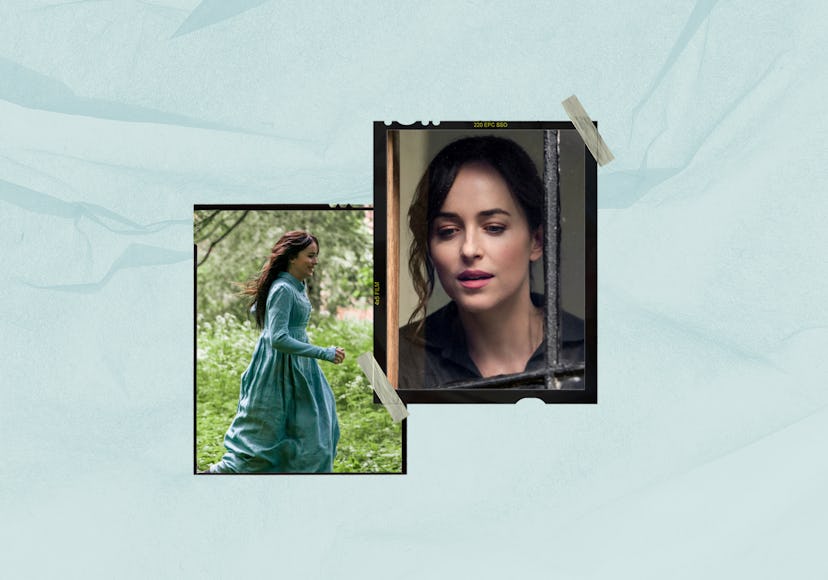TV & Movies
Let’s Talk About Dakota Johnson’s Hair In Persuasion
The whole movie is a misfire, but the bangs deserve special contempt.

Early signs were not promising for Netflix’s new adaptation of Jane Austen’s final novel, Persuasion. The release of a trailer featuring tongue-in-cheek, Fleabag-style asides to the camera and anachronistic dialogue was met with scorn. “Is the novel dead? If so this trailer killed it,” wrote Maris Kreizman, host of the literary podcast The Maris Review. Reviews were no kinder. Dana Stevens at Slate described the film as “not only the worst Austen adaptation but one of the worst movies in recent memory,” while the novelist and Austen aficionado Brandon Taylor titled a brutal installment of his newsletter dismantling the movie “persuasion (2022) is a hate crime.” But while this misbegotten adaptation, directed by Carrie Cracknell and starring Dakota Johnson, has been rightfully criticized for its hackneyed dialogue, ham-fisted characterization, and costumes more suited to 1914 than 1814, one crucial element has thus far escaped the scrutiny it deserves: Anne Elliot’s hair.
Why, in a movie so clunkily anachronistic that Anne describes her love interest as “a 10” and another character declares that she’s “an empath,” have I chosen to focus on hair? Because to Austenites, Anne’s hairstyling is equally egregious. As Anne, Dakota Johnson — with her signature long bangs and loose strands of hair framing her face — looks more like a millennial cottagecore influencer than anything.
In 1814, topknots for upper-middle class women were in. But they wouldn’t have let stray strands of hair loose, and they definitely wouldn’t have had bangs. They also wouldn’t have gone out in public — even the woods — with their hair down: “No one was walking around with their hair down unless you were a crazy person, or maybe a sex worker,” hair historian Rachael Gibson tells Bustle. “There were so many codes to how you could present yourself as a woman. If you were a certain member of society, it would destroy your reputation to walk around looking a certain way.”
Women did their hair this way for several reasons. The first was purely aesthetic: Regency England was infatuated with Classical art and architecture, and women’s hair and dress was inspired by Greek silhouettes, which featured topknots, curls, and ribbons. More practically, the United Kingdom’s middle class was expanding, and more people — like Anne Elliot — had money to spend on clothes and hair. As a result, middle- and upper-class women paid close attention to trends in hair and dress, and tailored their appearances to meet them; it probably wasn’t a coincidence, Gibson says, that this was the era that gave birth to hairdressing as a profession, as well as to hair and beauty magazines.
There’s an even more practical explanation for the styles of this era: Shampoo and conditioner didn’t yet exist, and women washed their hair once a month, if that. People’s hair was dirty, and keeping it tightly braided and up in a bun helped keep it clean — or, well, cleaner. “That’s the thing about so much of ancient history — people smelled really bad and things were kind of gross,” Gibson says. “You can’t underestimate that. People didn’t have this lovely, glossy flowing hair.” It would take people getting over their fear of overwashing (in the late 1800s, shampooing was blamed for everything from baldness to brain injury) and the invention of liquid shampoo in the 1920s to change that.
In the best period films, smart writing, art design, costumes, and, yes, hair and makeup all contribute to the illusion that the viewer has been transported to the past. Sometimes, a film will communicate something larger by making deliberate modern revisions — like A Knight’s Tale, which imports ‘90s style to medieval Europe in order to comment on contemporary celebrity culture. The latest adaptation of Persuasion, on the other hand, wants to be cheekily modern without saying anything new about the past or the 21st century — or the novel Persuasion, to which the adaptation bears little resemblance. In the movie, Johnson keeps her conditioned hair, laments about her “ex,” and brandishes a “playlist.” “It doesn’t work because they haven’t fully committed to the bit. Knowing more about the period might have allowed them to engage with it more effectively,” says Dr. Natasha Simonova, an English lecturer at Oxford, adding that Persuasion “comes off as both try-hard and lazy in its adoption of millennial memes.” So lazy that Anne looks like she walked straight out of 2022 into 1817. As Simonova tweeted, Johnson’s bangs (or “fringe, as the Brits would say) as Anne “is just… Dakota Johnson’s fringe.”
Despite what Persuasion would have you believe, women in the past walked around with dirty hair, body hair, and bad teeth. Most period films, though, avoid emulating that historical reality. Gibson believes that period productions, by and large, view historical accuracy in hair and beauty as an afterthought. “Everything else is going to be accurate, but you kind of think, oh, well, [hair and beauty’s] not really important. Let’s not bother, it doesn’t matter if it’s not right — and actually, that makes [the film] look most contemporary.” The lack of attention to hair and beauty is particularly galling in films set in early 19th century England, a period during which middle- and upper-class women were expected to do little besides marry and raise children. Hair and beauty, Gibson says, was “a way of expressing yourself when you haven’t got a voice in society … So to just completely ignore it and be like, well, it doesn't really matter — actually, it tells us so much about what’s going on in the world.”
If viewers want to watch a movie featuring a millennial woman with bottleneck bangs, they have plenty of options. Must she take over the past, too?
This article was originally published on